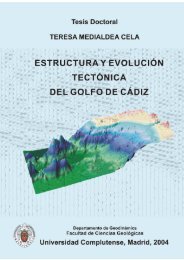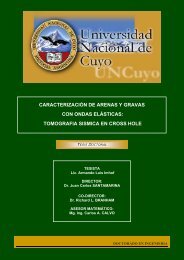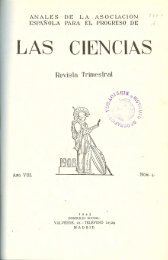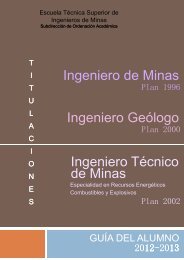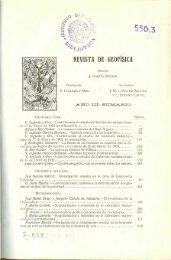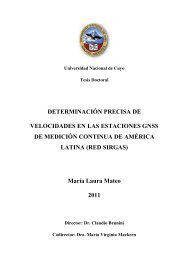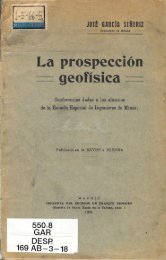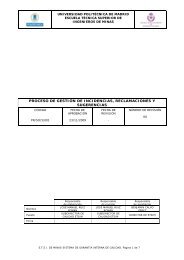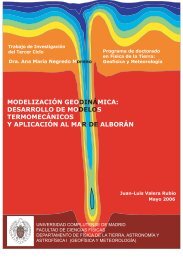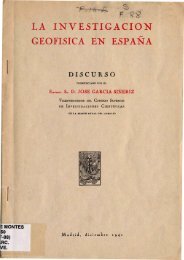estructura gravimétrica y magnética de la corteza del suroeste ...
estructura gravimétrica y magnética de la corteza del suroeste ...
estructura gravimétrica y magnética de la corteza del suroeste ...
You also want an ePaper? Increase the reach of your titles
YUMPU automatically turns print PDFs into web optimized ePapers that Google loves.
6. Separación <strong>de</strong> fuentes regionales y residuales<br />
Des<strong>de</strong> esta alineación hacia el sur y este, toda <strong>la</strong> parte suroriental <strong>de</strong>l mapa presenta<br />
fundamentalmente valores negativos <strong>de</strong> anomalía asociados a los sedimentos <strong>de</strong> <strong>la</strong> cuenca<br />
<strong>de</strong>l Guadalquivir.<br />
Del mismo modo que <strong>la</strong> anomalía positiva <strong>de</strong> Castilb<strong>la</strong>nco <strong>de</strong> los Arroyos, el gran<br />
mínimo que se apreciaba en el mapa <strong>de</strong> anomalías <strong>de</strong> Bouguer observada (fig. 6.3) en el<br />
extremo SE <strong>de</strong>l mapa, se ha dividido entre el mapa regional y el mapa residual. La<br />
componente regional <strong>de</strong>l mínimo se <strong>de</strong>be al aumento <strong>de</strong> espesor <strong>de</strong> <strong>la</strong> <strong>corteza</strong> asociado a <strong>la</strong>s<br />
Béticas como se indicó en el apartado anterior, mientras que <strong>la</strong> componente residual <strong>de</strong> este<br />
mínimo gravimétrico <strong>de</strong>be correspon<strong>de</strong>r a los sedimentos terciarios que rellenan <strong>la</strong> cuenca<br />
<strong>de</strong>l Guadalquivir y cuyo límite norte está marcado por una alineación <strong>de</strong> máximos <strong>de</strong><br />
pequeña longitud <strong>de</strong> onda entre <strong>la</strong>s localida<strong>de</strong>s <strong>de</strong> Ayamonte y Córdoba (ver mapa geológico<br />
<strong>de</strong> <strong>la</strong> fig. 2.4).<br />
6.3.3. PROFUNDIDADES DE LAS FUENTES MAGNÉTICAS<br />
En <strong>la</strong> figura 6.7 se muestra el mapa <strong>de</strong> anomalías aero<strong>magnética</strong>s utilizado para<br />
realizar el análisis espectral, obtenido <strong>de</strong>l Mapa Aeromagnético <strong>de</strong> España Peninsu<strong>la</strong>r<br />
(Ardizone et al., 1989).<br />
El mapa mostrado en <strong>la</strong> figura 6.7 se extien<strong>de</strong> entre <strong>la</strong>s coor<strong>de</strong>nadas X UTM 650000-<br />
950000 e Y UTM 4100000-4300000 correspondientes al huso 29, y tiene un espaciado <strong>de</strong><br />
5.000 m, igual que el mapa gravimétrico, para minimizar <strong>la</strong> influencia <strong>de</strong>l tamaño <strong>de</strong>l<br />
espaciado en el análisis espectral y po<strong>de</strong>r comparar los resultados obtenidos <strong>de</strong>l análisis <strong>de</strong><br />
<strong>la</strong>s fuentes <strong>gravimétrica</strong>s y <strong>magnética</strong>s. Esto <strong>de</strong>fine una mal<strong>la</strong> <strong>de</strong> 40 fi<strong>la</strong>s por 60 columnas.<br />
4300000<br />
4250000<br />
4200000<br />
4150000<br />
Barcarrota<br />
Jerez <strong>de</strong> los Caballeros<br />
Aroche<br />
El Cerro <strong>de</strong> Andévalo<br />
Gibraleón<br />
Cumbres Mayores<br />
Aracena<br />
Almonte<br />
Castilb<strong>la</strong>nco <strong>de</strong> los Arroyos<br />
Aznalcól<strong>la</strong>r<br />
Higuera <strong>de</strong> Llerena<br />
Montemolín<br />
Sevil<strong>la</strong><br />
Guadalcanal<br />
Constantina<br />
Carmona<br />
Morón <strong>de</strong> <strong>la</strong> Frontera<br />
Pozob<strong>la</strong>nco<br />
Córdoba<br />
Antequera<br />
4100000<br />
650000 700000 750000 800000 850000 900000 950000<br />
Montil<strong>la</strong><br />
Puente Genil<br />
Figura 6. 7. Mapa <strong>de</strong> anomalías aero<strong>magnética</strong>s utilizado en el análisis espectral. Coor<strong>de</strong>nadas UTM en metros,<br />
huso 29. Intervalo entre isolíneas <strong>de</strong> 20 nT.<br />
200 nT<br />
180<br />
160<br />
140<br />
120<br />
100<br />
80<br />
60<br />
40<br />
20<br />
0<br />
-20<br />
-40<br />
-60<br />
-80<br />
-100<br />
117



